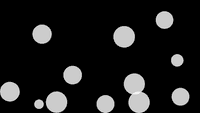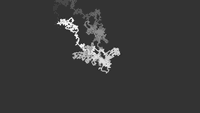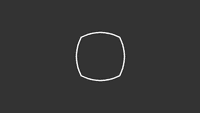Examples+
Non-orthogonal Reflection
by Ira Greenberg
Based on the equation (R = 2N(NL)-L) where R is the reflection vector, N is the normal, and L is the incident vector.
Highlighted Features
/**
* Non-orthogonal Reflection
* by Ira Greenberg.
*
* Based on the equation (R = 2N(N*L)-L) where R is the
* reflection vector, N is the normal, and L is the incident
* vector.
*/
// Position of left hand side of floor
PVector base1;
// Position of right hand side of floor
PVector base2;
// Length of floor
float baseLength;
// An array of subpoints along the floor path
PVector[] coords;
// Variables related to moving ball
PVector position;
PVector velocity;
float r = 6;
float speed = 3.5;
void setup() {
size(640, 360);
fill(128);
base1 = new PVector(0, height-150);
base2 = new PVector(width, height);
createGround();
// start ellipse at middle top of screen
position = new PVector(width/2, 0);
// calculate initial random velocity
velocity = PVector.random2D();
velocity.mult(speed);
}
void draw() {
// draw background
fill(0, 12);
noStroke();
rect(0, 0, width, height);
// draw base
fill(200);
quad(base1.x, base1.y, base2.x, base2.y, base2.x, height, 0, height);
// calculate base top normal
PVector baseDelta = PVector.sub(base2, base1);
baseDelta.normalize();
PVector normal = new PVector(-baseDelta.y, baseDelta.x);
// draw ellipse
noStroke();
fill(255);
ellipse(position.x, position.y, r*2, r*2);
// move elipse
position.add(velocity);
// normalized incidence vector
PVector incidence = PVector.mult(velocity, -1);
incidence.normalize();
// detect and handle collision
for (int i=0; i<coords.length; i++) {
// check distance between ellipse and base top coordinates
if (PVector.dist(position, coords[i]) < r) {
// calculate dot product of incident vector and base top normal
float dot = incidence.dot(normal);
// calculate reflection vector
// assign reflection vector to direction vector
velocity.set(2*normal.x*dot - incidence.x, 2*normal.y*dot - incidence.y, 0);
velocity.mult(speed);
// draw base top normal at collision point
stroke(255, 128, 0);
line(position.x, position.y, position.x-normal.x*100, position.y-normal.y*100);
}
}
// detect boundary collision
// right
if (position.x > width-r) {
position.x = width-r;
velocity.x *= -1;
}
// left
if (position.x < r) {
position.x = r;
velocity.x *= -1;
}
// top
if (position.y < r) {
position.y = r;
velocity.y *= -1;
// randomize base top
base1.y = random(height-100, height);
base2.y = random(height-100, height);
createGround();
}
}
// Calculate variables for the ground
void createGround() {
// calculate length of base top
baseLength = PVector.dist(base1, base2);
// fill base top coordinate array
coords = new PVector[ceil(baseLength)];
for (int i=0; i<coords.length; i++) {
coords[i] = new PVector();
coords[i].x = base1.x + ((base2.x-base1.x)/baseLength)*i;
coords[i].y = base1.y + ((base2.y-base1.y)/baseLength)*i;
}
}
Related Examples
This example is for Processing 4+. If you have a previous version, use the examples included with your software. If you see any errors or have suggestions, please let us know.





